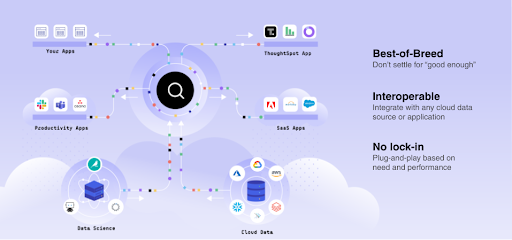For decades, the technologies and systems that deliver analytics have undergone massive change. What hasn’t changed, however, is the goal: using data-driven insights to drive actions. Insight to action has been a consistent vision for the industry. Everyone from data practitioners to technology developers have sought this elusive goal, but as Chief Data Strategy Officer Cindi Howson points out, it has remained unfulfilled — until now.
The combination of the cloud ecosystem and open APIs have finally turned the tide, making it possible at long last to truly go from insight to action.
The insight to action disconnection
Using legacy tools, data professionals and power users have been able to identify insights in their data. The problem, however, was the real gap between those insights and the actions they needed to trigger.
Think of the typical process for customer analytics: you want to know which customers in a loyalty program have not made a purchase in the last 30 days. You can create this report in your analytics and BI tool, but then what? You want to use that insight to do something to engage with those customers, so by sending them a personalized message with a coupon. To do so, however, you may email the list to a marketing operations specialist or enter the data into a marketing communications platform.
The action is disconnected from the insight, and requires extensive human intervention before anything is actually triggered.
Finally bridging the gap
The rise of the cloud ecosystem, where platforms are open and connected via APIs, has fundamentally rewritten the rules of what’s possible when it comes to insight to action. With the Modern Analytics Cloud, customers can move away from the old, broken process, and instead, close the loop from insight to action. Anyone can use search and AI to find insights, then push those insights back into an operational application, a business application like Salesforce, or productivity apps like Google Sheets to trigger an action.

It’s not just easy for business users. Low-code integration means an analytics engineer can implement this workflow without a lengthy development process or custom coding. Use cases can be launched faster than ever, and built right into existing workflows. In doing so, insights are scaled across organizations like never before, instigating actions driven by intelligence.
What to do about it in 2022
To seize the holy grail of analytics in 2022, where anyone can find insights and use them to drive action, resolve to:
Ideate which insight to action processes would provide measurable business impact.
Identify processes that require manual data integration between insight platforms and operational systems as candidates for modernization.
Be ruthless in assessing costs to retrofit legacy applications – which are often sunk costs – versus modernizing and upgrading.
If you want to dig deeper and learn how to capitalize on the most important data, analytics, and AI trends coming next year, download our 2022 trends and predictions guide here.







